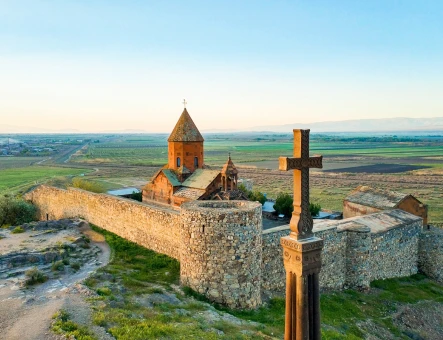Group tour: Khor Virap Monastery, Azat Reservoir, Garni Temple, Lavash baking master class, Geghard Monastery
Khor Virap Monastery, Azat reservoir view point, Lunch stop, Lavash baking master class, Garni Temple, Geghard Monastery
1. Khor Virap Monastery
50-60 min























2. Azat Reservoir
10-20 min





Lunch stop
50-60 min
Option 1 (vegeterian) – 3900 AMD per person
Option 2 – 4500 AMD per person
Option 3 – 4900 AMD per person
Lavash baking master class
15-20 min

















Lavash is one of the most popular gastronomic icons of Armenia, serving as an integral part of the Armenian cuisine. It is a traditional soft, thin flatbread, made in tonir (special ground oven). Although the baking process of lavash requires much of special skills, it is undertaken by women. For centuries lavash has been consumed by all classes of Armenian society, it is valued for the unique taste and the ability to be stored for quite a long period of time without losing its positive qualities.
In 2014 "The preparation, meaning and appearance of traditional bread lavash as an expression of Armenian culture" was inscribed in the UNESCO Representative List of the Intangible Cultural Heritage of Humanity.
During this master class you will observe and learn the millennia-old techniques of making lavash, and, of course, taste self-baked lavash together with some fresh greens and yummy local cheese. Feeling the smell of lavash once, you will save this impression for the whole life:)
3. Garni Temple
60-70 min

























4. Geghard Monastery
60-70 min
































Inclusions
-
Professional guide: ENG + RUS consecutively
-
Air-conditioned vehicles
-
Bottled water & pastries
-
Admission tickets
-
Wi-Fi in the vehicles
-
Vehicle & passengers insurance
-
Master class & tasting
Exclusions
-
Lunch cost (10.39 USD – 13.06 USD)
-
Hotel drop-off (final stop: our office)
Highlights
- Embrace the stunning views of Biblical Mount Ararat
- Marvel at the one of a kind nature of Armenia from a special view point
- Explore the 1st century pagan temple
- Discover the legends of St. Lance used by the roman soldier to sting Jesus Christ's side
- Taste most delicious Armenian traditional bread
Frequently Asked Questions
Is there any distance to be carried on foot?
Does Azat Reservoir look the same way as it is in photos?
How will you describe lavash baking master class? Can I take part in the lavash baking procedure?
Can I pay for the lunch in the restaurant by card?
What is the group size for this tour?
Are there any clothing requirements or recommendations for this tour?
Booking conditions
Cancellation & modification
Meet our Guides

Karen Khachatryan
Dear friends, my name is Karen, and I am your guide through the amazing Armenia. My many years of experience allow me to conduct fascinating tours to the most popular and interesting places in the country. I bring history to life, sing psalms in ancient churches, and tell captivating legends, making your journey unforgettable. With me, you can expect a safe, informative, and vibrant trip!

Khachatur Mirzoyan
My name is Khachatur, which is the Armenian variation of Chris (Christopher), and I'm comfortable with that as well. I have been working as a tour guide since 2012. I'm a sociable person, love interacting with people, and always do my best to make sure the tour lives up to our guests' expectations.

Marina Mirumyan
Hi, my name is Marina Mirumyan, and I am a tour guide at "Hyur Service" company. Haven't traveled to Armenia yet? Then plan a visit and be our guest! Join my tours with "Hyur Service" to discover the endless hospitality of our people, the breathtaking views of our mountainous country, the ancient culture, traditions, delicious cuisine, and much more! Travel with "Hyur Service" to create lasting memories!

Tamara Arakelyan
I am Tamara. I live in Armenia and through Armenia. If you want to feel the taste, scent, and colors of Armenia and fall in love with our country, then let's go on a tour together. Just like all my guests, I'm sure you too will want to come back again.



